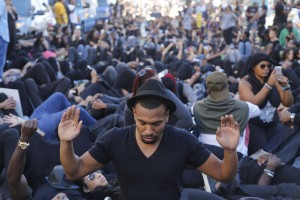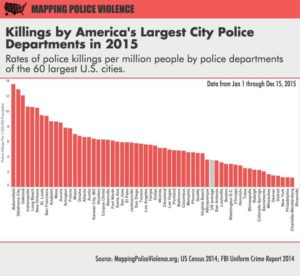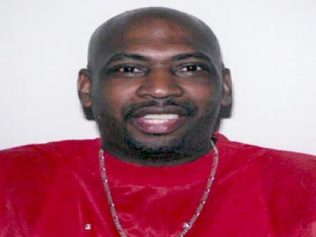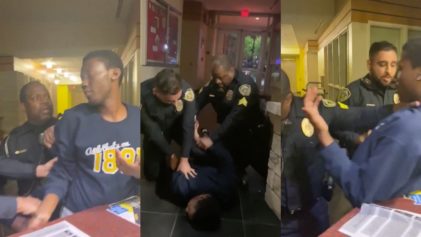Campaign Zero, the new #BlackLivesMatter organization dedicated to ending police violence in America, has released the 2015 Year-End Police Violence Report through their Mapping Police Violence Project. This revealing report, which examines police killings in the 60 largest cities in the country, provides a valuable look at a growing problem, reinforcing what some in the Black community have maintained for quite some time, and debunking arguments often made by critics and detractors of the Black anti-police brutality movement.
The main takeaways—police kill many people, disproportionately Black, and violent crime does not make police violence any less or more likely.
The report, a study of national data from January 1 through December 15 of this year, found that the police kill a great number of people, although the 60 largest cities are all over the map when it comes to the number of police killings. Over the past year, 1,152 people were killed by the police, with a quarter of these, or 249, committed by the police departments in the 60 largest cities. These cities account for 17 percent of the U.S. population.
Meanwhile, not all cities are the same. Police in 59 of the 60 cities killed people in 2015, with the Riverside Police Department having no killings this year. They were the only department to have no killings.
St. Louis police killed people at a rate seven times higher than Philadelphia police. Overall, the national leaders with the highest rates of killings included police departments in Bakersfield, Oklahoma City, Oakland, Indianapolis Metropolitan, Long Beach, New Orleans, St. Louis Metropolitan and San Francisco.
With the nation’s highest per capita rate of police killings, Kern County, California—in which Bakersfield is located–was featured in a report by the Guardian in December. With a population of around 875,000, Kern County has had 13 police killing this year, while New York City—with a population ten times larger and a police force 23 times greater—had nine people killed by police in 2015. The Guardian report points out that while most police officers never have to use their weapon once during their career, one Bakersfield police officer was involved in four fatal shootings in two years, in a town where many believe “you have to support the police and whatever they do is correct.” Bakersfield is 46 percent Latino, 8 percent Black and 38 percent white, yet 74 percent of the police officers are white, 21 percent are Latino and less than 5 percent are Black. Kevin McCarthy, who represents Bakersfield in Congress, is a conservative Republican member of the Tea Party.
Further, it should be no surprise to the Black community and racial justice activists that Black people were disproportionately killed by police in the nation’s largest cities. Of these 60 cities, 41 killed Black people at a rate higher than their representation in a given jurisdiction. Black people represented 41 percent of the victims, yet only 20 percent of the population in these areas. Moreover, in 14 cities, the police killed Black people exclusively, and no one else. In only five police departments did whites constitute 100 percent of all victims at the hands of police.
Perhaps most importantly, there is no correlation between the amount of violence in the community and the level of police violence, the report found.
“Rather than being determined by crime rates, police violence reflects a lack of accountability in the culture, policies, and practices of the institutions of policing, as investigations into some of the most violent police departments in America have shown,” said the report.
Campaign Zero notes that police in low-crime cities such as Austin, Bakersfield, and Long Beach have killed people at higher rates than police in high-crime jurisdictions such as Detroit and Newark.
This final point is significant because some politicians, law enforcement officials, conservative think tanks and other critics of Black protest have cast aspersions on #BlacklivesMatter, in an attempt to criminalize, suppress and silence the racial justice movement and Black political protest in general. In the process, they tacitly or explicitly justify the violence against Black bodies as necessary, even preferable, to maintain law and order. Without evidence to substantiate their claims, critics have promoted the concept called the “Ferguson Effect.” This is the baseless notion that police officers, under scrutiny by Black protesters over their aggressive tactics and afraid to be videotaped, are less willing to enforce the law and do their jobs, resulting in a jump in crime. The Ferguson Effect has become a popular Republican talking point, with presidential candidates Ted Cruz and Chris Christie taking it even a step further and insisting that #BlackLivesMatter celebrates dead cops and, along with President Obama, encourages lawlessness and places the lives of law enforcement officers in danger. This, in a year with the second lowest number of murdered police in decades, according to the Washington Post.
Even law enforcement groups reject the notion of soaring crime rates.
“Crime in the U.S. is at an all-time low across the country, and we expect it to stay that way,” said Ronald Serpas, Chairman of Law Enforcement Leaders to Reduce Crime and Incarceration, and former Superintendent of the New Orleans Police.
“Despite some misleading reports about a surge in crime rates, the data show just the opposite. In fact, as recent studies show, the overall crime rate will be lower this year than it was last year, and half of what it was in 1990. Some cities have seen a rise in murder, but these are isolated incidents—not a new crime wave—which local leaders are taking steps to address,” Serpas added. “At this moment of rare national consensus that incarceration levels in this country have reached a crisis point, we cannot let sensational headlines slow the momentum to reduce unnecessary incarceration.”






